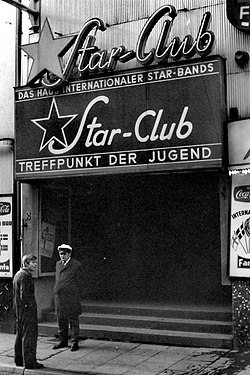Star-Club
 Entrance to the Star-Club, Hamburg. 1968 | |
 | |
| Location | Hamburg, Germany |
|---|---|
| Public transit | |
| Owner | Manfred Weissleder and Horst Fascher |
| Type | Nightclub, music venue |
| Genre(s) | Rock and roll |
| Capacity | 2,000 |
| Opened | 1962 |
| Closed | 1969 |
The Star-Club was a music club in Hamburg, Germany, that opened on Friday 13 April 1962, and was initially operated by Manfred Weissleder and Horst Fascher. In the 1960s, many of the giants of rock music played at the club. The club closed on 31 December 1969 and the building it occupied was destroyed by a fire in 1987. The address of the club was Große Freiheit 39 in the St. Pauli quarter of Hamburg. Große Freiheit is a side street of the Reeperbahn. The club had a capacity of 2,000 people, and cinema-style seating.[1]
The club achieved worldwide renown through the performances of The Beatles, who played there 13 April – 31 May, 1–14 November, and 18–31 December 1962. A performance or parts of several performances from the end of the latter stay was or were recorded on a home tape machine, and a remixed version was released in 1977 as Live! at the Star-Club in Hamburg, Germany; 1962.
The Beatles' first Hamburg Club performance was at the Indra Club (also on Große Freiheit) on 17 August 1960.
Musicians who played at Star-Club

List of musicians who played in the Star-Club:[2]
- American musicians:
- Ray Charles
- Bo Diddley
- Fats Domino
- Everly Brothers
- Bill Haley
- Jimi Hendrix
- Johnny and the Hurricanes
- Brenda Lee
- Jerry Lee Lewis (who released a highly praised live album recorded at the club in 1964)
- Little Richard, who at that point had Billy Preston in his band
- The Monks, with Gary Burger, Eddie Shaw, Dave Day, Roger Johnston and Larry Clark played at the Top Ten Club a number of time 1965, 1966, and 1967.[3]
- English musicians:
- The Beatles
- Cliff Bennett and the Rebel Rousers
- The Big Three
- Black Sabbath
- Chicken Shack, featuring Christine McVie
- Cream
- Lee Curtis and the All-Stars
- Dave Dee, Dozy, Beaky, Mick & Tich
- Earth (pre-Black Sabbath)
- The Graduates
- Gun
- The Jimi Hendrix Experience (US/UK, March 1967)
- The Jaybirds, featuring Alvin Lee, Leo Lyons and Pete Evans.
- Innocent Child – Blackpool Rock Band (originally Cherry Blossom Clinic)
- Billy J. Kramer
- The Dakotas
- The Liverbirds
- The Londoners
- Maze featuring Ian Paice and Rod Evans later of Deep Purple
- The Overlanders
- The Pretty Things
- The Remo Four
- The Searchers
- Kingsize Taylor and the Dominoes
- Richard Thompson
- Soft Machine
- The Twilights
- Tony Vincent and The Giants
- Jane Cane (jazz singer)
- The Roadrunners – Liverpool's original R & B band of the 60s
- Katch 22 – London band formed in 1966
- Terry Slater and The Flintstones
- The Undertakers(Band) German musicians: The Rattles and many more
- Casey Jones & The Governors
- Italian musicians:
- Benjamin & His Brothers – Rock 'n' Roll band featuring Mino Reitano
- Swedish musician:
Star-Club Records
In October 1962, Siegfried Loch, label manager for Philips Records, visited the Star-Club for a concert with Fats Domino. Loch persuaded Manfred Weissleder, the manager of Star-Club, to give him permission to set up recording equipment in the club.[4] He started a record label, Star-Club Records, subsidiary of Philips Records.
References
- ^ https://www.rollingstone.com/music/music-features/why-beatles-star-club-tapes-best-represent-the-groups-early-bar-band-spirit-203454/amp/
- ^ "Archived copy". Archived from the original on 2011-07-08. Retrieved 2011-01-17.
{{cite web}}: CS1 maint: archived copy as title (link) List of musicians who played in the Star-Club - ^ Book, Black Monk Time
- ^ "The Beatles' Star Club Recordings The Reel Story - Record Collector Magazine". recordcollectormag.com.
External links
- http://www.center-of-beat.com/ Information about the Star-Club
- http://www.starclub-hamburg.eu/ Information about the Star-Club
- http://www.merseycats.com/Maja's-Memories-of-the-Star-Club.html Reminisce to the opening of the Star-Club, with an original recording of the Beatles ("A Taste of Honey")
- http://beatles.ncf.ca/starclubtapes.html Eric Krasker, The Star-Club tapes : The set that never existed.
